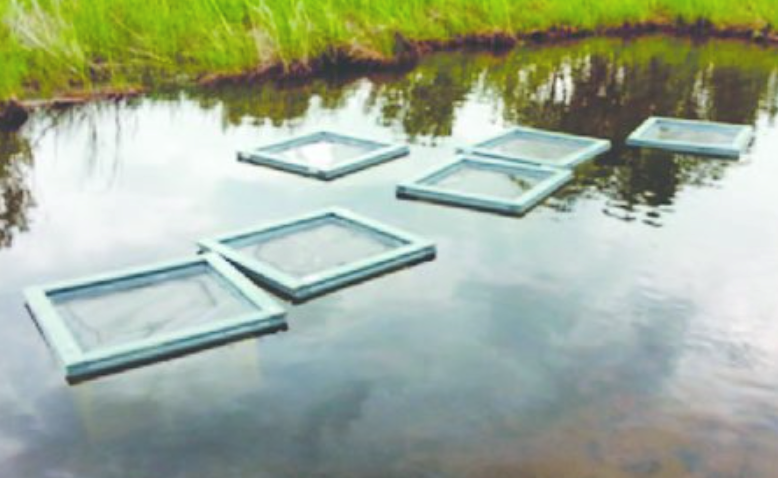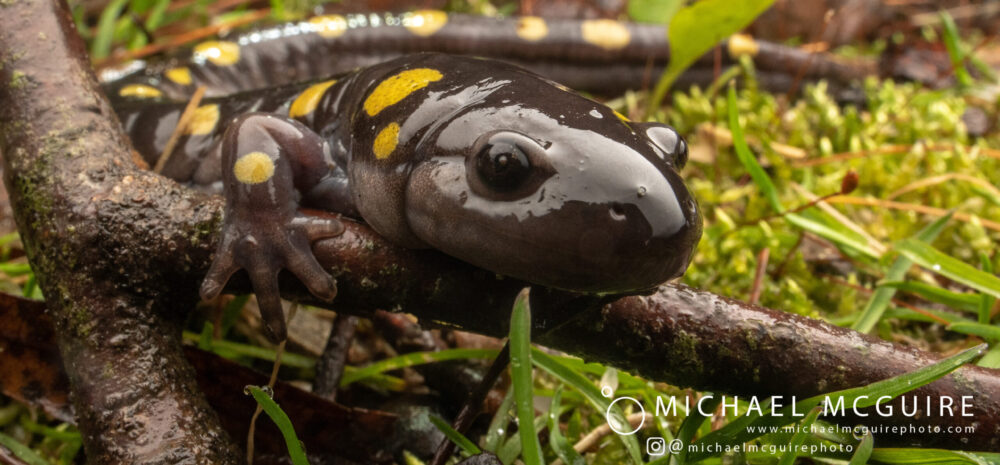By Juniper Nardiello Smith

Imagine you are a 0.002-pound frog burrowed in the mud on the edge of a forested pond with the exact coloration of the dead leaves that litter the ground around you. Now imagine that you notice fewer and fewer of your fellow species members around you, your population is decreasing. Global warming is changing the composition of your habitat. Your skin is too hot. Invasive plant species are taking over the landscape and making it harder and harder to find food. Pesticides sprayed on crop fields make you sick. Loud machinery breaks your habitat into many pieces as roads wind through the once whole landscape and buildings scatter the land. You find yourself risking your life to cross these roads. These obstacles are sadly the reality that amphibians, such as the little frog you imagined, toads, and salamanders face every day as their natural habitats are altered by humans. These are also some of the primary factors that contribute to making amphibians one of the most critically threatened group of organisms on the planet. Their small size, cryptic coloration, and varied habitat use make it hard to notice and understand, without really searching, how these factors are affecting amphibians. Because of this, I am taking this time to advocate for these organisms that often go unnoticed by discussing an eye-opening study that hits close to home. Unfortunately, here in Vermont, where there are more cows than people and corn fields seem to stretch out towards the mountains as far as the eye can see, we might be posing a bigger threat to these little guys than we realize.
An Eye-Opening Study
Farming, something deeply rooted in the history and culture of Vermont, has been found to facilitate in a decline of amphibian survival. An article titled “Pesticides in the Real World: The Consequences of GMO-Based Intensive Agriculture on Native Amphibians” published earlier this year outlines a study conducted in South America to test how different pesticides used in agriculture affect amphibian survival. The motivation behind this study was due to the fact that the use of pesticides on agricultural fields has been suggested as a top driver of the amphibian decline we are seeing globally. Because our population continues to grow, so does our food demand. This will likely make it so GMOs and agriculture will only intensify resulting in an increase in pesticide use. To test these impacts researchers studied 71 ponds adjacent to agricultural fields that were likely to contain pesticides. Four species were selected to observe based on the knowledge that they tend to have their breeding sites in ponds found in agricultural fields.

Within each pond, mesh enclosures, like the ones pictured above, were built to hold tadpoles found within that pond for observation. Farmers determined the combinations of pesticides used to spray on their individual fields to meet the requirements of their crops. The researchers surveyed the tadpoles three times to determine how well they could move and their survival, 24 hours before pesticides, 24 hours after pesticides, and 48 hours after pesticides (Agostini et al., 2020). I wish I could say the frogs that involuntarily found themselves in this experiment were alright, but that would be far from the truth. The results from this study bring up a conflict in Vermont involving the continued use of pesticides found to be harmful in this study.
The Conflict
With the exception of one, all of the pesticides used in this study are currently still being used in Vermont. Fortunately, the one pesticide banned in Vermont, endosulfan, was found to be the most toxic to frogs in this study. However, combinations of other pesticides like chlorpyrifos and glyphosate reduced survival to 1.8% and combinations of cypermethrin and glyphosate reduced survival to 10.5% after 48 hours. Glyphosate, known commonly as Roundup, is highly used in Vermont to the point where its use has almost doubled in the past decade. Glyphosate did not significantly reduce survival on its own but was found, along with all the other pesticides, to have significant negative effects on mobility. The effects of these pesticides on survival were so extreme that mobility could not be measured after 48 hours in all of the ponds due to the low number of surviving tadpoles. Although Vermont is a very different place than South America and contains different amphibians, all of them share the unique trait of highly sensitive skin. We also share the use of many of the same pesticides all of which have the same chance of showering down on a cattle pond or washing away with the rain into a nearby body of water. Here in Vermont, the pesticides have the same ability to coat the skin of frogs, covering their habitat, their food, providing young frogs with pesticides for breakfast. Despite these similarities a study conducted in South America cannot provide us with the data we need to make a change here in Vermont. A study must be conducted on our own sweet-smelling manure covered fields.
Why Does this Matter?
Before I can convince you that a study must be done in Vermont to gain a better understanding of the impacts of our pesticide use on frogs and other amphibians, it is important to understand why they matter and why they are worth conserving. Currently 41% of all amphibian species are experiencing threatening populations levels. To put this into context only 12% of birds and 24% of all mammals are threatened. Focusing on amphibian conservation is very crucial right now as these small animals are experiencing a rapid decrease in biodiversity. However, conserving amphibians isn’t just in the best interest of all the frogs, toads, and salamanders out there. There is also some incentive for us to conserve amphibians because they provide us with several services. Most notable is their role as bioindicators. A term that they acquired because their sensitive skin makes them more susceptible to diseases, indicating to scientists’ locations that contain negative environmental factors. Amphibians also pose an important role in their food chain as they are food to larger prey and they eat many insects. These feeding habits maintain mosquito populations helping to reduce the spread of illnesses like malaria and regulate the populations of crop destroying insects. Amphibians in their aquatic stage also feed on algae which helps to keep our waters clear and clean. Among other services being studied, amphibians have the potential to help combat climate change and treat diseases like Alzheimer’s and cancer through the particular chemical compositions found on their skin (Rosenberg, 2019). If we don’t begin advocating for amphibians, we may miss out on our chance to help them and in turn never know how much they really could have helped us. As much as amphibians need us right now, we need them.
Moving Forward
If you’ve fallowed me this far it should be apparent that amphibians are in need of a fair amount of TLC. In a state where we heavily participate in an activity that is known to be a top driver of amphibian decline, reducing our impacts on such threatened species should be a top priority. The results from the study done in South America are disturbing and have pushed me to advocate for a study to be conducted in Vermont to test how our state’s top used pesticides are interfering with amphibian survival in our ponds and waterways. The Environmental Protection Agency (EPA) is required to evaluate environmental risks such as risks to wildlife and threatened species when reviewing pesticides (US EPA, 2013). However, these risks cannot be assessed if data has not been collected on them. The issue of rapid amphibian decline, and the impacts of increasing pesticide use as a growing population demands more food is an issue that can’t change unless awareness, advocacy, and action are brought to the table. These 0.002 pound, borderline invisible, amphibians desperately need a voice to stick up for them. We all have the power to be this voice.
Literature Cited
Agostini, M. G., Roesler, I., Bonetto, C., Ronco, A. E., & Bilenca, D. (2020). Pesticides in the real world: The consequences of GMO-based intensive agriculture on native amphibians. Biological Conservation, 241. https://doi.org/10.1016/j.biocon.2019.108355
Rosenberg, C. (2019). Why the loss of amphibians matters. MNN. https://www.mnn.com/earth-matters/animals/stories/why-loss-amphibians-matters
US EPA. (2013). About Pesticide Registration [Overviews and Factsheets]. US EPA. https://www.epa.gov/pesticide-registration/about-pesticide-registration
Photo two: Yagi, K. T., & Green, D. M. (2016). Mechanisms of Density-dependent Growth and Survival in Tadpoles of Fowler’s Toad, Anaxyrus fowleri: Volume vs. Abundance. Copeia, 104(4), 942–951.
